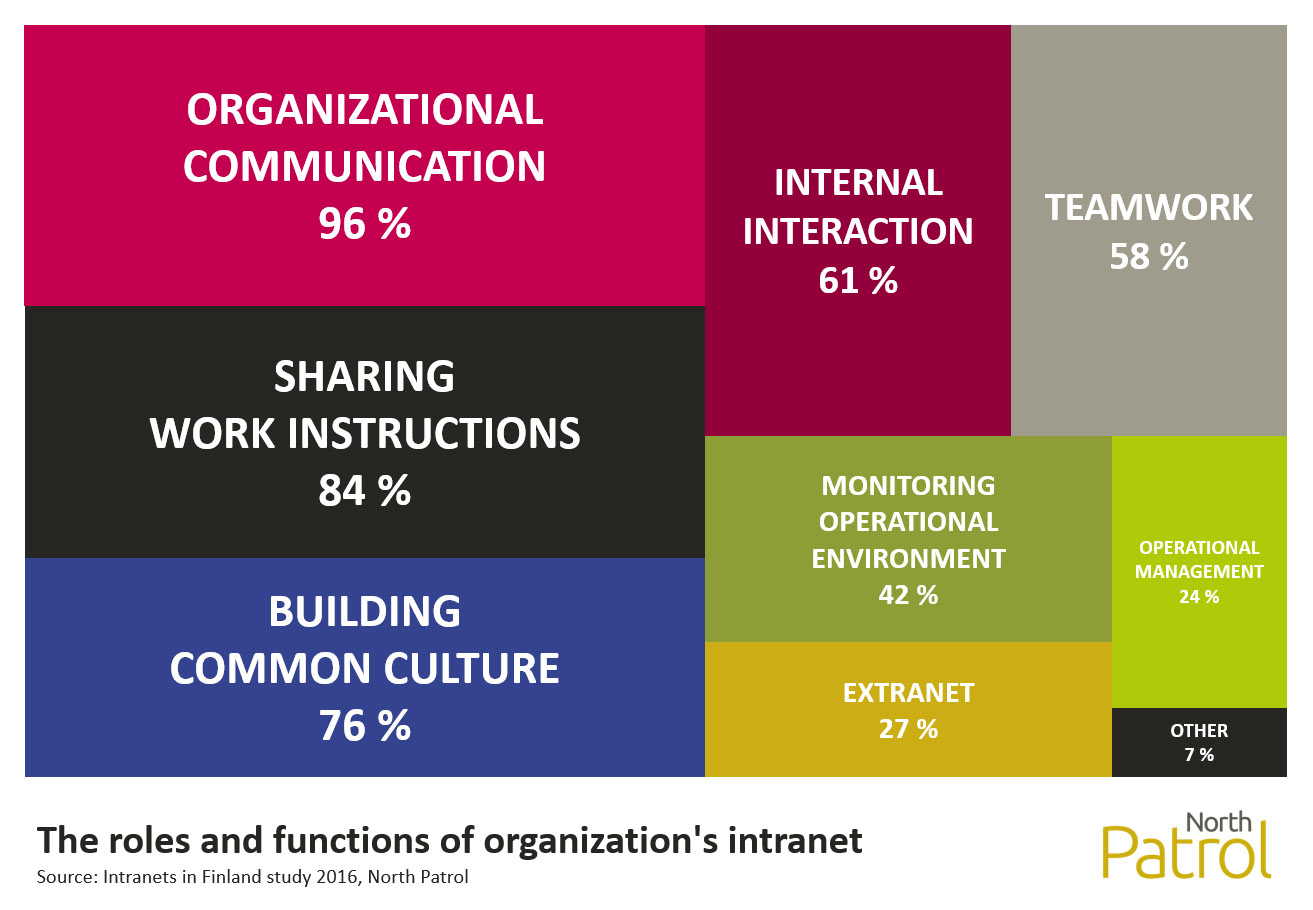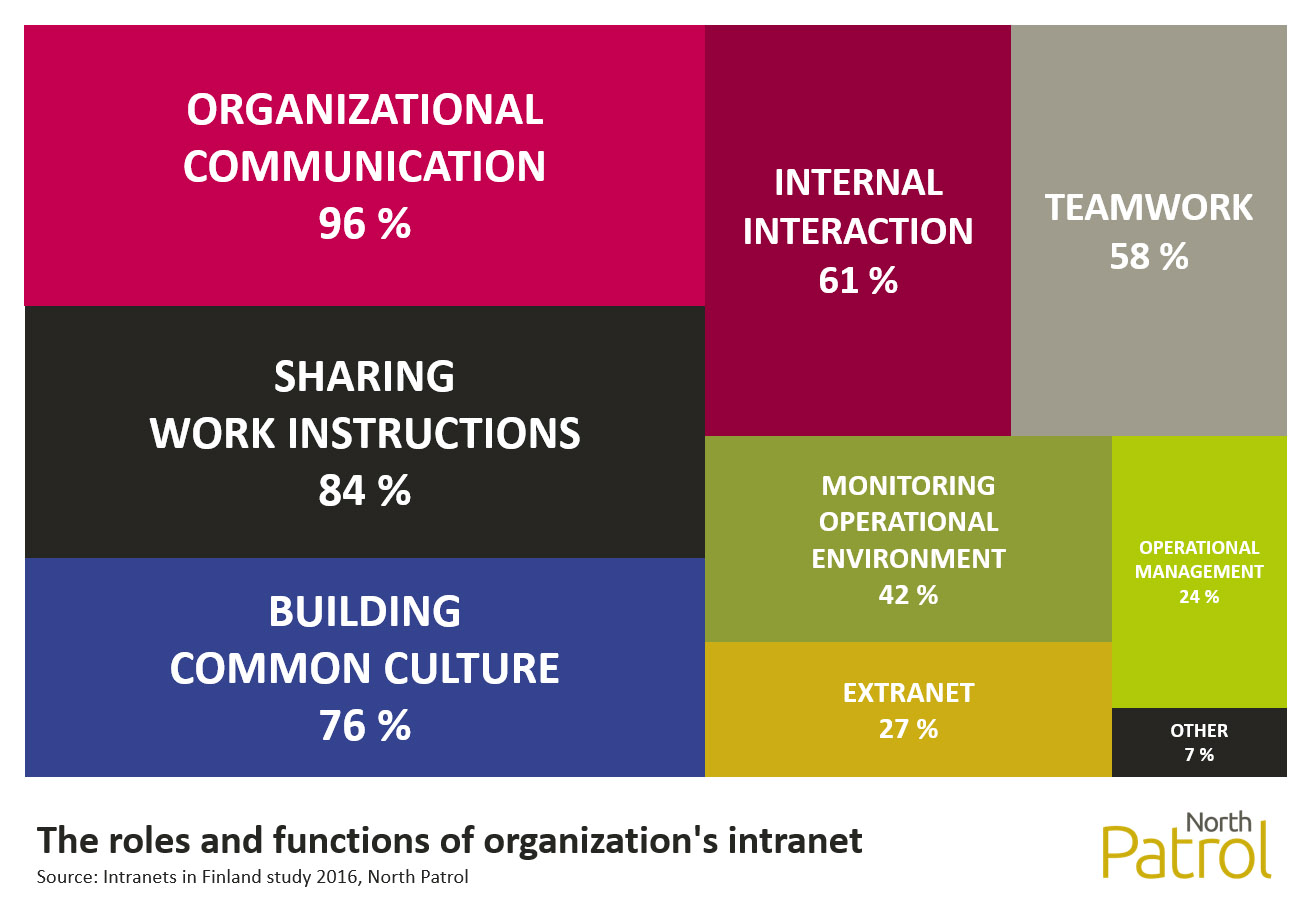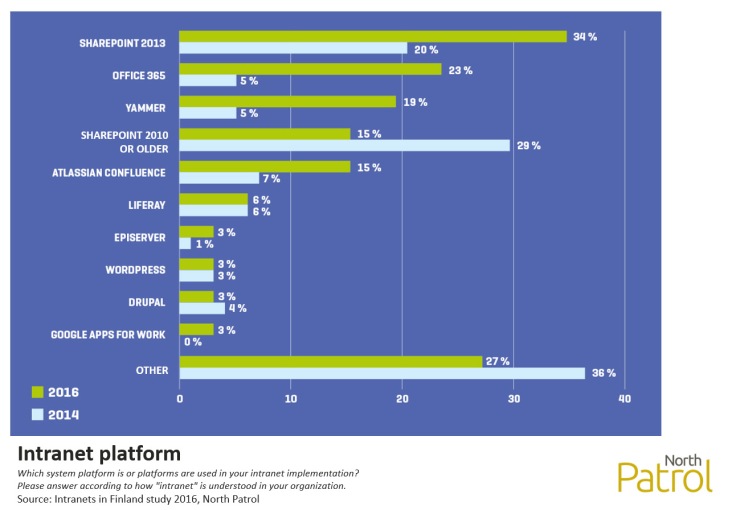Intranets in Finland are used for organizational, HR, and strategic communications, and to communicate company policies and guidelines. On top of these two traditional roles, most of the intranets are also tools to facilitate the forming of a common organizational culture and sense of community, our latest study on Finnish intranets reports.
North Patrol is a consulting firm specialized in the design of digital services and information systems. We shape ideas into a vision and service concept, find the best architectural and technological solutions, design a functional user experience, and compete to find the ideal partner for implementation work. We do not sell implementation projects, nor do we sell licenses; we are genuinely on the side of the customer.

Role: Intranets as strategic tools?
Even though intranets have a major role in facilitating organizational communication, culture, and collaboration, few intranet managers see their intranets are strategically and methodically managed. Managing an intranet is mainly about content strategy and management, outlining a publishing policy, and supporting the network of content editors.
One fourth of all intranets have a shared role of supporting business, or managing/guiding everyday work (e.g. via supply chain management). These roles might be operationally critical, and because of that, there is a clear correlation between intranets which are used as business-critical tools and those that are managed in a strategical manner.
The role and functions of your organization’s intranet (*
* Question: An “intranet” is the internal digital operating environment of an organization. Organizations may understand it in slightly different ways. An “intranet” may also refer to a system built on several technology platforms. Below are some of the most typical functions of intranets. Please give your answer to the next question – and all the following questions – based on how “intranet” is understood in your organization. Check all the functions for which your intranet entity is being used. NB! See the full explanations of the roles at the end of this page.
Content types and functionalities: Videos are the new black
According to the respondents, video is THE most fascinating content type – also on intranets. The usage of internal videos has risen significantly. It is still the number one content or functionality (of 44 elements studied) the respondents will increase investments on.
Finnish intranets are very social: in almost all intranets users can make comments, like articles, and share thoughts and discuss.
The most common content types and functionalities on Finnish intranets (2016)
| Element | % (* |
| Guides on internal services/support functions | 98 |
| Internal bulletins and news | 97 |
| Human Resource guidelines | 97 |
| Shortcuts/links to systems and tools | 97 |
| Basic facts about the organization, its strategy and operational principles | 94 |
| Comments and/or likes for content | 89 |
| Company telephone directory | 88 |
| Free-form discussion forums | 82 |
| Lunch menus | 81 |
| Event and/or training calendar | 80 |
* % of respondents with this functionality or content type on their intranet.
NB! See the full list at the end of the page.
The most relevant content types or functionalities Finnish intranet managers will invest in in the near future (2016)
33 %(* Videos
32 % Strategic key indicators/metrics
31 % Group chats/communication (such as Yammer, Slack, HipChat)
28 % Teamwork spaces for business units or teams
27 % Teamwork spaces for project groups/teams
27 % Sharing day-to-day feelings about work (such as pictures or videos)
26 % Social media feed/s shown on intranet pages
25 % Collaboration on work documents
24 % Background and justification for management decisions or policies
24 % Integration with one or more business systems
* % of respondents who state that their “organization will put more effort in the development of the following item”.
Platform: More cloud, more SharePoint
The market share of SharePoint as the leading intranet platform in Finland has been rising constantly. This is partly due to the popularity of the Office 365 cloud platform which includes a cloud version of SharePoint. Office 365’s market share is almost 1/4 (as the only intranet platform or as one of several platforms used).
The popularity of SharePoint and Office 365 shape the role and tasks of intranets in Finland. For example, over half of the respondents say their intranet is used also as a tool for team and project work. And one fourth have extended their intranets into extranets, too.
Popularity of SaaS and PaaS has effects on how organizations see information security. Over half of the intranets are now accessible from the publicc internet with username and password alone, and with any device. Almost 50 % of the respondents say their intranet is responsive.
Intranet platform (*
* Question: Technology. Which system platform is or platforms are used in your intranet implementation? Please answer according to how “intranet” is understood in your organization.
Intranets in Finland study
Biannually we run an intranet study covering the current intranet market and future trends in Finland. This article is based on our latest results from 2016.
The survey was answered by 119 respondents, mainly communication managers responsible for their organization’s intranet. It was an open call to contribute to the study.
The online survey included 28 questions varying in type and scope. We put the focus on intranet’s role and governance. The present status and future focus areas of 44 typical intranet elements in total were investigated. They fall under four themes: Common content and functionality; Operational management; Teamwork and collaboration; and Social interaction, involvement and personalization.
The study will be conducted again in 2018.
The role and functions of your organization’s intranet (*
* Question: An “intranet” is the internal digital operating environment of an organization. Organizations may understand it in slightly different ways. An “intranet” may also refer to a system built on several technology platforms. Below are some of the most typical functions of intranets. Please give your answer to the next question – and all the following questions – based on how “intranet” is understood in your organization. Check all the functions for which your intranet entity is being used.
- 96 % Organizational communication. Publishing common policies and guidelines, as well as official internal and HR communication, change and strategic communication.
- 84 % Sharing work instructions. Guidelines for working methods in processes, business units/segments/divisions and/or work roles.
- 76 % Building common culture. Supporting and reinforcing communality and a common culture.
- 61 % Internal interaction. Work-related and internal communication of units, departments, and division, and peer-to-peer support for projects, workgroups, teams and/or roles.
- 58 % Teamwork. Intranet as a teamwork platform where different teams collaborate digitally.
- 42 % Monitoring operational environment. Following external stakeholders and operating environment (media monitoring, customer feedback, market reviews, social media monitoring etc.).
- 27 % Extranet. Communication and/or working with external stakeholders.
- 24 % Operational management. Managing practical daily operational processes (chain management, task monitoring, goal metrics etc.).
- 7 % Other
The most common content types and functionalities on Finnish intranets (2016)
| Element | % (* |
| Guides on internal services/support functions | 98 |
| Internal bulletins and news | 97 |
| Human Resource guidelines | 97 |
| Shortcuts/links to systems and tools | 97 |
| Basic facts about the organization, its strategy and operational principles | 94 |
| Comments and/or likes for content | 89 |
| Company telephone directory | 88 |
| Free-form discussion forums | 82 |
| Lunch menus | 81 |
| Event and/or training calendar | 80 |
| Several topic categories for news | 77 |
| Work instructions for work processes and tasks | 74 |
| Internal interaction (electronic forms and workflows) | 72 |
| Videos | 72 |
| Teamwork spaces for project groups/teams | 71 |
| Teamwork spaces for business units or teams | 69 |
| Personnel profiles | 67 |
| Real-time instant messaging (such as Skype, Lync, HipChat) | 66 |
| Media monitoring results | 66 |
| Collaboration on work documents | 65 |
| Sharing day-to-day feelings about work (such as pictures or videos) | 61 |
| All users can publish notifications/news | 60 |
| Background articles and/or personal interviews (as in an employee newsletter) | 58 |
| Information on the services and/or products your organization offers | 58 |
| Personnel buy & sell classifieds | 57 |
| Public encouragement and commendation | 55 |
| Strategic key indicators/metrics | 54 |
| Management blog or other management-created content | 54 |
| Social media feed/s shown on intranet pages | 53 |
| User blogs | 52 |
| Group chats/communication (such as Yammer, Slack, HipChat) | 49 |
| Day-to-day communication and/or tasks for different work roles or work functions | 48 |
| Newsfeeds are profiled for different groups/roles | 44 |
| Background and justification for management decisions or policies | 43 |
| Possibility to invite external people to teamwork spaces | 41 |
| Business reports | 38 |
| Suggestions box | 37 |
| Integration with one or more business systems | 33 |
| Users can personalize their front pages (or other views) | 30 |
| Questions and answers | 26 |
| Publishing customer feedback | 23 |
| Work process key indicators and metrics | 19 |
| Competitor and/or market analysis | 13 |
| Automated notifications from other systems (such as CRM) | 6 |
* % of respondents with this functionality or content type on their intranet.


